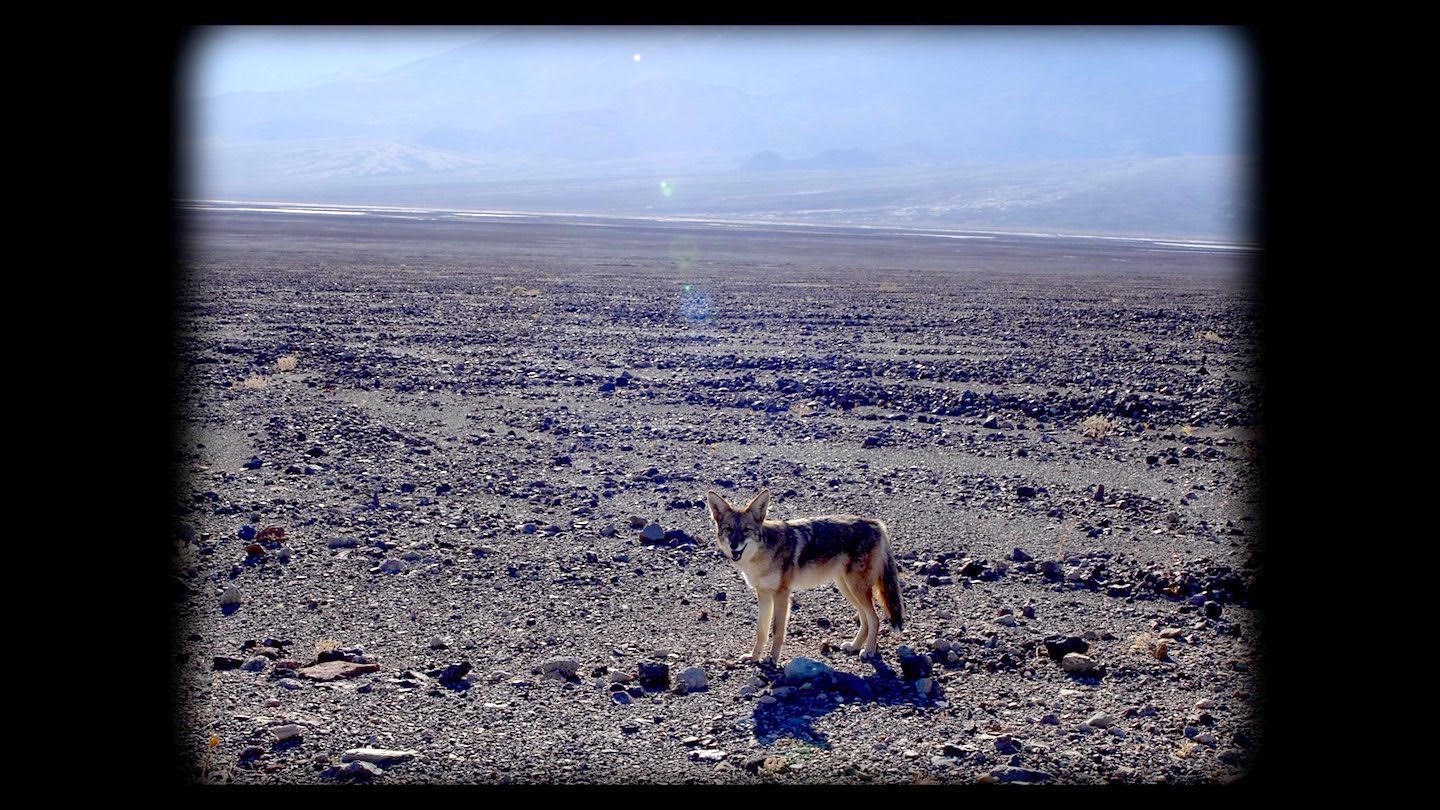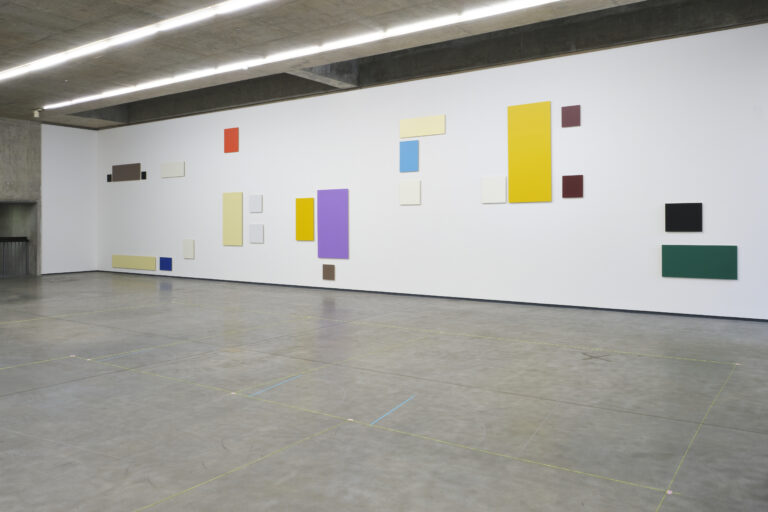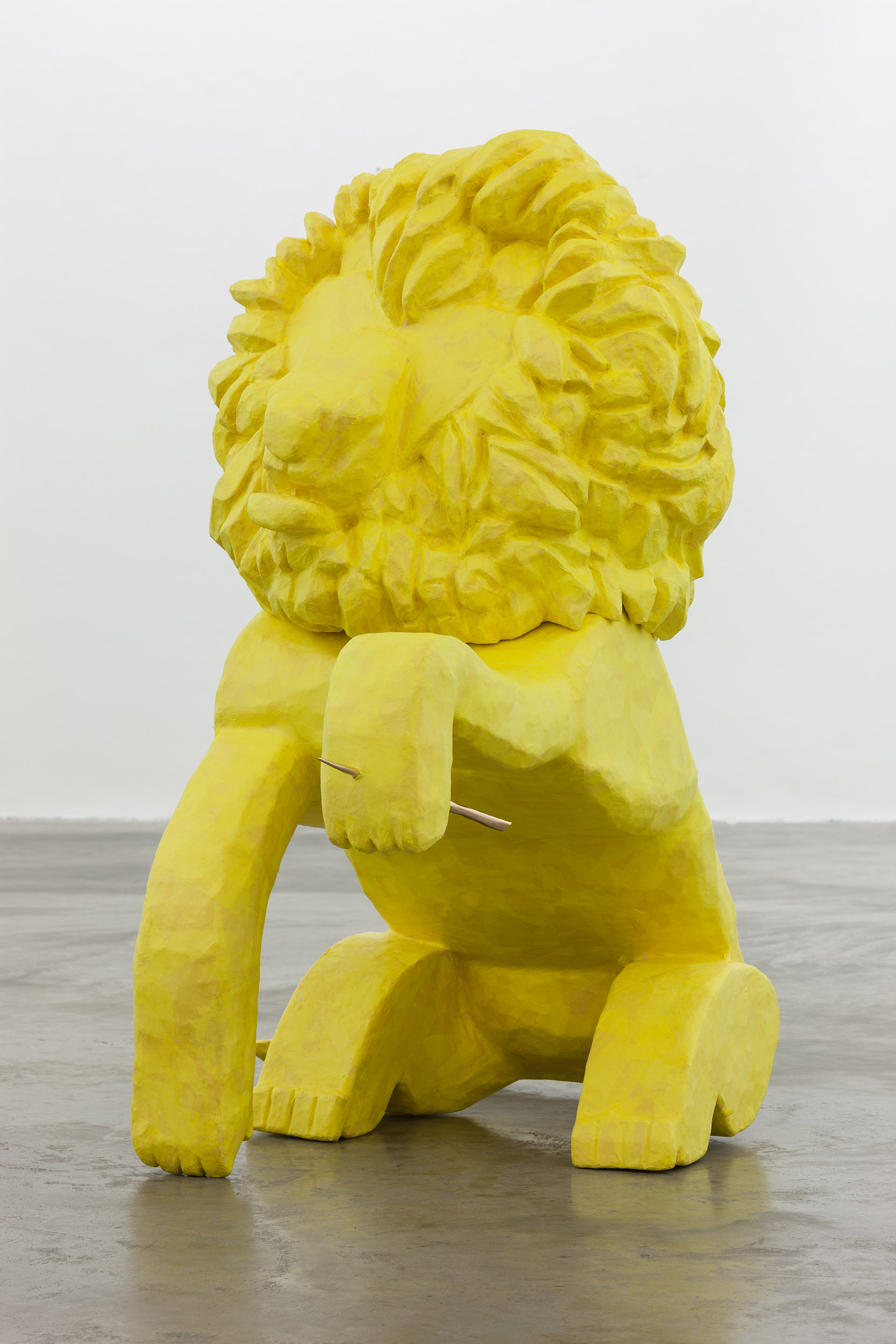When I started art school exactly ten years ago, I was seventeen and deeply religious. Afforded my first real opportunity to make work, I painted what was true to me. Abstracted crucifixes and scenes from the Book of Revelation filled my studio; think less iconography and more Patrick Pye. A couple of visual culture lectures in and I found myself knee-deep in Lucy R. Lippard’s Six Years: The Dematerialization of the Art Object from 1966 to 1972 (1973). Hyper-intellectual 1960s New York art practices, championing idea over form or feeling, seemed like a much more reputable path. I destroyed all my religious work and started again. Interested in ephemerality, I began performing. I wrote my final year thesis challenging Peggy Phelan’s ‘The Ontology of Performance’ (1991), a project I am still pursuing.
After graduating, I began to write. I quickly became fluent in International Art English, indulging in the nonsense of press-release language about humourless art objects. Struggling with my faith, I hid behind rationalist rhetoric, the dominant discourse around visual art in the West.
In 2023, after years of desperately maintaining a practice while working in sales and finance, not to mention the countless failed art-job interviews, I started full-time curatorial work. This year I also officially became an Irish citizen, an identity shift that has weighed on me more heavily than I could have anticipated. A year of big wins also saw big losses, my faith included. Frustrated with my NPC psychotherapist, I took to TikTok to find ways to cope. The predominant pieces of self-help advice I gathered: ‘feel your feelings’, ‘drop into your body’, ‘stop intellectualising your emotions’.
***
How can we de-intellectualise visual art? If asked this a year ago, I think I’d have pushed back at the very premise. Why would intellect be a problem? Why shouldn’t we value theory? There’s nothing wrong with an intellectual approach to art, per se, but it seems to me that its dominance of the field has been a problem, gradually burying the visual under layer after layer of theory. We have all visited an exhibition we’ve enjoyed on some level but not quite understood, skimming the press release for guidance, often to no avail. In such cases, I don’t believe the issue is with the work – which resists all our intellectual bubble wrap anyway – but with how the work is disseminated through language: titles, press releases, descriptions, and so forth. Over the decades, this has thinned out audiences for visual art, catering for increasingly niche, specialised visitors. Looking back on my first decade in the arts, I can recognise this as the prevailing norm. It’s something I admit I’ve perpetuated myself, as recently as this year.
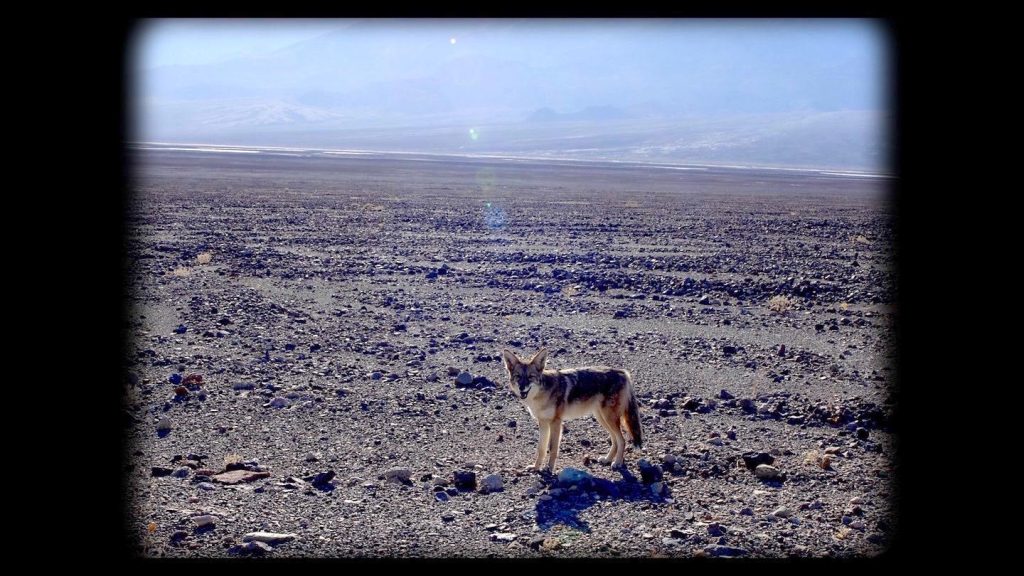 Katherine Waugh and Fergus Daly
I See a Darkness, 2023
Film still from the exhibition at Photo Museum Ireland
Courtesy of the artists
Katherine Waugh and Fergus Daly
I See a Darkness, 2023
Film still from the exhibition at Photo Museum Ireland
Courtesy of the artists
‘Maslow’s Hammer’ – a proposition by American psychologist Abraham Maslow – suggests that when you have a specific tool or mental model, you tend to see everything as if it can be solved or understood using that tool or model. The colloquial phrasing is: if the only tool you have is a hammer, everything looks like a nail. Since my early art school days, I’ve been under the impression that the only valid way to approach art is through the intellect, but I now suspect that maybe thinking through art isn’t as effective as we’d like. I’m reminded of poet and civil rights activist Maya Angelou who said: ‘I’ve learned that people will forget what you said, people will forget what you did, but people will never forget how you made them feel.’ Audiences may forget what an artwork was made of, or what it ‘meant’, but I don’t think we’ll forget if it made us feel something.
The power of an emotive response is well-known of course. In politics, emotive drives are recognised as a potent strategic force. Voters across the political spectrum tend to make decisions based on emotional reactions rather than intellectual analysis. Politicians know how to play the game. They know we will side with whatever riles us up the most. We are almost a decade into what’s often called the ‘post-truth’ era, in which the influence of objective fact on public opinion has receded in favour of emotion and belief, and we are still grappling with the consequences of this shift. In the political realm, emotions are weaponised. Fears are sharpened into certainties. Visual art, on the other hand, is a space for uncertainty, or for multiple uncertainties. It’s somewhere that subjectivity and expression can happen freely, speculatively. Many of us in the arts do not use this space nearly enough. What if we were to operate from this vantage point, making use of new tools, so to speak? What would happen if we stepped out of our intellect and dropped into our bodies?
Thankfully, more and more artists seem to be asking this question, pushing back against the idea of the artwork as primarily cerebral or intellectual. Since 2019, I see it less and less. It is difficult to pinpoint when the shift began, an oscillation of shifting institutional personnel, a tacit acknowledgment of the exclusionary nature of specialist language, and an unspoken resurveying of the art scene as a whole, in Ireland and internationally.
 Bassam Issa Al-Sabah
IT’S DANGEROUS TO GO ALONE! TAKE THIS, 2022
Single-channel video
Courtesy of the artist
Bassam Issa Al-Sabah
IT’S DANGEROUS TO GO ALONE! TAKE THIS, 2022
Single-channel video
Courtesy of the artist
This has overlapped with a drive, in recent years, to make art accessible to broader audiences. There’s a tricky issue here. The movement toward accessibility can sometimes suggest simplification or dilution of an artwork’s criticality or rigour. It’s a question that crops up in different ways from exhibition to exhibition. But what we have started to do, I think, is modify our exhibition spaces to be more welcoming. Our language is becoming more intentional. The keys to the kingdom are slowly being multiplied. Fundamentally, there is an urgency to the work being created that reaches beyond language or framing. The preoccupations of artists are shifting. We’re ‘shuffling through our toolbox’, so to speak.
I haven’t been an art student for some years. I graduated from the MA Art in the Contemporary World at NCAD in 2018. However, from my brief experience of hosting crits with TU Dublin Fine Art undergraduates earlier this year, the work being produced by new artists is overwhelmingly more personal and urgent than that of some of my peers a decade ago. Two of the students at TU were making work about their gardens. A handful were focused on their identity. Another was taking a comedic angle on the housing crisis. The artists who have graduated since the pandemic seem disenchanted with theory, maybe because the social structures around them are in such disarray. Exhibitions and essays exploring materiality have been my bread and butter, but they have come to seem superfluous in a political moment such as ours.
The past year has seen the clearest shift I have seen in my short career towards a de-intellectualised position in the visual arts in Ireland. This has taken several shapes, but for me there are two dominating tendencies: an acknowledgement of the individual’s enmeshment with technology, and an earnest effort to mobilise collectively. Notice how different these two ideas are, highlighting the ever-present struggle between the individual and the collective. They are also deeply entangled. Technological enmeshment leads to increased isolation, especially in young people, yielding a desire for forms of community that can act as antidotes.
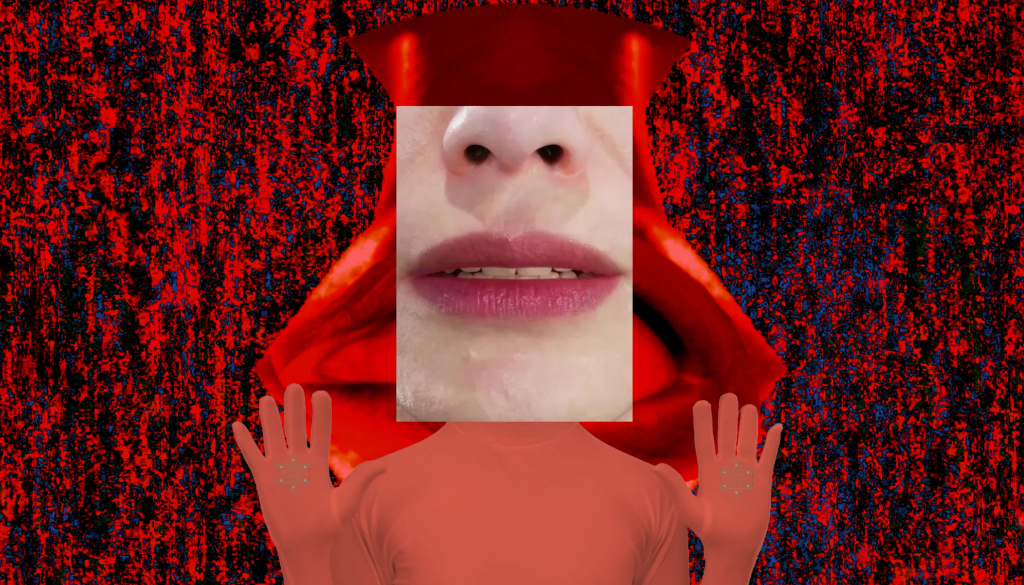 Elaine Hoey
Prosthetic Knowledge, 2022
Interactive digital artwork
University College of Cork Art Collection. Commissioned by The Glucksman.
Courtesy of the artist
Elaine Hoey
Prosthetic Knowledge, 2022
Interactive digital artwork
University College of Cork Art Collection. Commissioned by The Glucksman.
Courtesy of the artist
Of the works selected for this year’s Periodical Review at Pallas Projects / Studios, there are a few that speak most clearly to these two themes. First, Tamsin Snow’s Relic (2023). I was obsessed with this installation after seeing it in the Cork Centre for Architectural Education during Cork Midsummer Festival. Its atmosphere felt weirdly eerie, despite every element of the installation seeming extremely familiar. SIM cards, SIM card trays, and SIM pins were scattered throughout the space. An admission: I spent well over a year working at eir back in 2017 and I must have handled and inserted up to a hundred SIMs a day. I have an intimate understanding of SIM cards: how best to pop them out, the logic behind their serial numbers. I’ve hand cut both of my parents’ SIMs to nano size because they didn’t want to risk losing their contacts with a SIM replacement in Vodafone. This is a niche skill, I realise, that maybe made me more excited about the work than I should have been. Snow’s SIMs are distilled down to their most basic elements (i.e., no logos, no serial numbers, or plastic film), they were tucked into corners of the space, easily missed or confused with the architecture of the room. The pièce de résistance, however, was the arrangement of pristine ATMs which, in spite of all their familiarity, made me feel like I was walking into a SketchUp model. So wholly artificial and unworldly. Relic is a reminder that everyday technology will soon be obsolete, a commentary on the speed with which we use and discard it.
I also love Luke Van Gelderen’s video work, HARDCORE FENCING (2023) though it simultaneously makes me uncomfortable: an engrossing mix of appropriated footage of natural disasters, varying kinds of violence, clips of the most iconic/problematic internet personalities, comedy, and everything in between, the work is underscored with an ambient soundtrack of impending doom and manosphere monologues. There’s a lonely tone to this work, a presentation of the nihilism of contemporary life through the lens of an iPhone. I can really feel the deep indulgence in parasocial relationships that people rely on to soothe their isolation. I’m quite sensitive to these things, on account of being sheltered for most of my formative years, but there’s something universally uncomfortable about watching a child disrespectfully slap his father. HARDCORE FENCING is an unflinching account of the absurdity of online space. Growing up, my mother would warn me of the futile, meaningless lives lived by ‘worldly’ people. This video strikes the tone of her view of ‘godless’ people to a T.
In stark contrast to this aesthetic of being chronically online, Fiona Hallinan’s We Turn Towards an Ending and Pay Attention (2023) considers what is lost as the Catholic Church in Ireland recedes from its position of primacy. Hallinan tells this story by proxy, through an exploration of the destruction of the Church of the Annunciation in Finglas. This work was first shown in VISUAL Carlow and has been my favourite work of this year. I found great comfort in its delicate and heartfelt conversations about the consequences of great socially progressive strides for those who still see the church as gathering point and space to practice ritual. As I am letting go of the worldview with which I was brought up, it felt validating to see my experience of spiritual pause reflected in visual art. I assume that most of my peers aren’t losing sleep over the rate at which religion is declining in Ireland, and I’m not saying I am, but I do think about the consequences of what I leave behind as I step into a new ideology. Progress is necessary, and I feel grateful to this work for showing how we might do this with care.
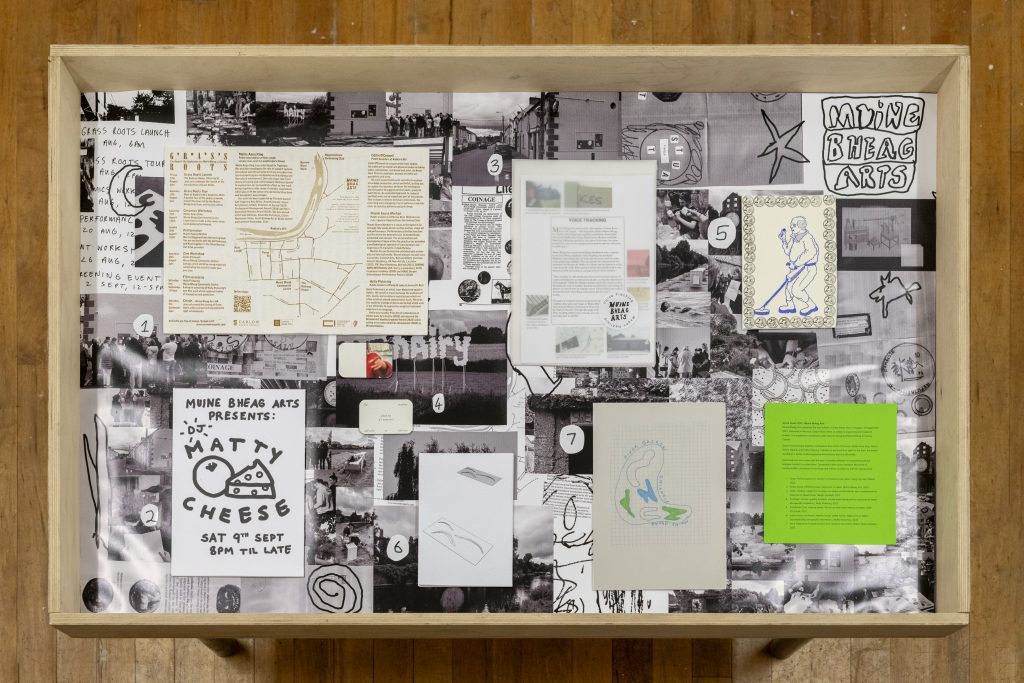 Periodical Review 13, Maslow’s Hammer, installation view, Grassroots/Muine Bheag Arts
Courtesy of Pallas Projects
Photo: Louis Haugh
Periodical Review 13, Maslow’s Hammer, installation view, Grassroots/Muine Bheag Arts
Courtesy of Pallas Projects
Photo: Louis Haugh
Lastly, a project I’ve greatly admired: Muine Bheag Arts, comprised of Mark Buckeridge and Leah Corbett, have created a series of public interventions exploring folklore, land ownership, identity, and place in County Carlow. From what I can gather, their programme is grounded in local, collective organising; commissioning site-specific pieces and one-off events. The spirit of the project is genuine and inclusive, animated through an array of practices. It’s the kind of initiative that seems genuinely meaningful to those involved, instead of trying to align with other work produced on some sort of national or international stage. Increasingly, this is the kind of work I aspire to make and facilitate.
This is, I’ll admit, a work in progress. Unlearning the methods that have gotten me this far is difficult. I hid behind theory for ten years. On the one hand because I am genuinely really into this stuff (while recognising it as a little torturous), and on the other because I could defer any question to a book, an ‘authority’ (cut to me studying and teaching analytic philosophy for the last four years). No working-class, closeted Pentecostal to see here.
Now, instead, I’m wondering if maybe the paradigm shift could be as easy as asking, the next time you visit an exhibition, not ‘what did you think?’ but ‘how did you feel?’
***
I recognise that writing publicly about losing my faith and getting mental health advice from TikTok might be the definition of oversharing. But maybe doing the vulnerable thing is the perspective shift we need, resisting the urge to just pick up the hammer. My hammer is theory. Maybe your hammer is something else. Overall we’re doing better, but our usual tools aren’t working as well as we’d like them to. Consider this my gesture of handing you a screwdriver, to see if it might helps shift our experience of art and, more broadly, this space we call the art world.
I don’t know if this is an effective approach, but if you try it then maybe you can let me know in my DMs.
cu multa dragoste [Romanian sign-off, meaning ‘with much love’]
Sara Damaris M. is a writer and curator based in Dublin.
This essay was commissioned by Pallas Projects and PVA, as part of the ‘PPS/PVA Visual Art Writing Commission’. It was written (and originally printed) to accompany Pallas’s Periodical Review 13, 1 December 2023–27 January 2024.

